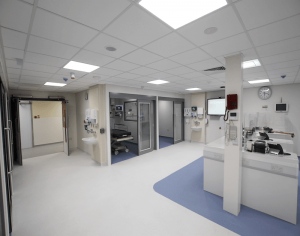Modular construction and automation are not new concepts in the construction industry, but the unprecedented circumstances we find ourselves in relating to the current COVID-19 pandemic has propelled them into the limelight. Off-site construction is heralded as being the safer, quicker and cheaper way to deliver new developments, could COVID-19 be the event that finally pushes more developers and contractors to take the leap?
With commentary from NG Bailey and Laing O’Rourke, Procure Partnerships Key Account Manager for the West Lauren Banks explores the benefits of automation and modularisation for the industry and how advances in technology have the potential to revolutionise the way we work.
Why Automation and Modularisation?
Interest in modern methods of construction and offsite manufacturing is gaining real traction in the construction industry. Pockets of best practice can be found across the UK and contractors are starting to take control by investing in their own off-site manufacturing facilities. Despite this, most buildings in the UK are still currently procured and constructed using traditional methods and we are not yet seeing off-site solutions being deployed on a large scale across multiple building types.
Many construction sectors customers are still largely unaware of the potential benefits of off-site manufacturing and how it can help to address some of the challenges we currently face. Firstly, traditional construction techniques are labour intensive. They rely on skilled labour to deliver good quality results and these results can often vary throughout the industry. In some areas of the UK the demand for skilled labour outweighs the supply; there just aren’t enough skilled people to do the job and as a result, costs can escalate.
Secondly, despite the huge strides we have taken as an industry, construction sites are still inherently unsafe, and the management of risk remains a huge part of the building process. We must still rely on employees to make safe choices and exhibit the right behaviours in an often unpredictable environment. The current pandemic has tested us further and the necessity to tighten controls and implement social distancing has greatly impacted productivity.
A third point to consider is the excessive amount of waste produced by our industry and the urgent requirement to design waste out of the building process. Construction, demolition and excavation activities generated around 62% of UK waste in 2016 and the industry must make fundamental changes to the way we work in order to meet our Net Zero Carbon commitments.
Many of these pressing issues can be overcome using the innovative technological advances associated with automation and modularisation, which present us with opportunities to reduce our reliance on labour, to improve safety and support social distancing requirements through the provision of a controlled working environment, and to eliminate waste from the process to create a more sustainable industry.
The Benefits of Modular and Off-Site Construction
Many developers and contractors are embracing off-site approaches to help them improve predictability and consistency and deliver better outcomes for their customers. The UK Government’s 2017 Transforming Infrastructure Performance report recommended swifter uptake of off-site manufacturing to help improve productivity and save money. This is incredibly important for public sector customers who, especially in the current climate, need to improve value for money.
Building components in a factory environment allows for greater quality control and removes many of the restrictions associated with building on site, such as bad weather, the necessity to control noise in sensitive locations, and various access and logistical issues.
NG Bailey has embraced off-site manufacturing as a key part of their strategy to develop a modern construction approach. Pat Morrison, Pre-contract Manager for Healthcare projects, comments:
“The philosophy behind offsite manufacturing is really based around standardisation and a modern method of approach; it means large parts of building services being pre-designed, manufactured and procured earlier, with delivery at the optimum point within the construction process. This is a change to the traditional method of construction, where a building is designed first and then assessed for prefabrication later. By designing the building around a catalogue of pre-designed components efficiencies are created at every stage, meaning customers benefit in terms of quality, programme and cost savings. It was through this approach that enabled NG Bailey to deliver three of the UK’s Nightingale Field Hospitals concurrently in response to the COVID-19 pandemic, and we are now developing new components to help drive greater efficiencies into the UK’s next major new hospital infrastructure development programme. NG Bailey has been pioneering the use of offsite manufacture for many years, providing innovative solutions through their specialist production facility in Yorkshire. The benefits of offsite manufacture in the construction and services industry are well documented, and NG Bailey, the UK’s leading independent engineering and services business, has been working with customers for many years to leverage these techniques and the benefits they bring to the industry.”
As off-site becomes more mainstream, many contractors are convinced the future lies in this method of production and are incorporating it into their long-term strategies. Tom Higgins, Laing O’Rourke, Construction Director credits this approach for the success of many of their complex and time critical projects:
“We have believed for many years that DfMA and off-site manufacturing are vital to boosting productivity and creating the robust construction sector this country needs. It is the basis of Laing O’Rourke’s operating model and something we continue to invest in. We operate our own UK factories located in in Nottinghamshire, from which we have designed and manufactured technically complex components for more than 350 UK buildings and infrastructure projects.
Across our portfolio, we continue to see the benefits of this approach in numerous sectors. DfMA and off-site manufacturing has been instrumental in enabling us to deliver The Grange University Hospital one year early and make ward space available to the NHS during the current pandemic. At Hinkley Point C power station in Somerset, advanced digital engineering tools and off-site manufacturing have improved construction efficiency, with the project setting new delivery standards and hitting key milestones set four years ago. Our DfMA-led approach has also been critical to accelerating progress on HS2, the extension of terminal 2 at Manchester Airport and on Manchester Metrolink, with the Trafford Park Line being completed seven months ahead of schedule earlier this year.
Looking to the future, it’s become very clear over the last three months that an increasing number of clients, both public and private sector, are starting to see the benefits of this more modern and sustainable method of construction – and more importantly are keen to adopt it. With the Government now acutely aware of the strategic importance of our sector to the UK economy and its rapid recovery post Covid-19, widespread change across the sector in favour of automation and modularisation feels imminent.”
Platform Construction
In the future, a shift towards a ‘platform approach’ to DfMA is anticipated, which will bring cohesion across sectors and provide enhanced opportunities for the extended supply chain.
A Platform DfMA approach would use a set of digitally designed components, designed to work across many types of built asset, such as a school, a hospital or a train station, to minimise the need to design bespoke components. All buildings would effectively start from the same ‘platform’ and be added to and adapted to suit the individual requirements. Components ideally suited might include wall and floor panels or roofing systems and would easily connect to a structural frame solution in flexible configurations.
Akin to that of the automotive manufacturing process, Platform DfMA would approach building design as being a system of parts that can change, develop and adapt over time, meaning their useful life can be extended and remain relevant for future generations.
The versatility to apply the system across various building types would create high volumes of demand, making it a viable and appealing opportunity to the extended supply chain who would make the common components. It is supply chain cohesion that will generate the economies of scale to dramatically increase productivity and reduce cost, and which has the potential to move modular construction into the mainstream.
What are the Barriers?
Currently, the majority of buildings in the UK are individually procured, conventionally designed and constructed on site using traditional skills and materials. The demand for off-site is still inconsistent and this will continue to curb growth until volumes are sufficient enough to make investment for the supply chain viable. Customers also need the confidence that offsite facilities are readily available, and a secure and robust supply chain is ready to deliver critical delivery timescales, creating a catch 22 situation!
This is something that through the Construction Sector Deal and the Transforming Construction Programme, the government is looking to change to enable growth in the sector. With the recent commitment from the government to use the construction industry to help kickstart the economy post Covid, perhaps this is the opportunity to help off-site construction and automation gather the momentum it needs to ‘disrupt’ the industry? When skilled people combine with technology the possibilities to create a more agile and sustainable industry, are endless…



